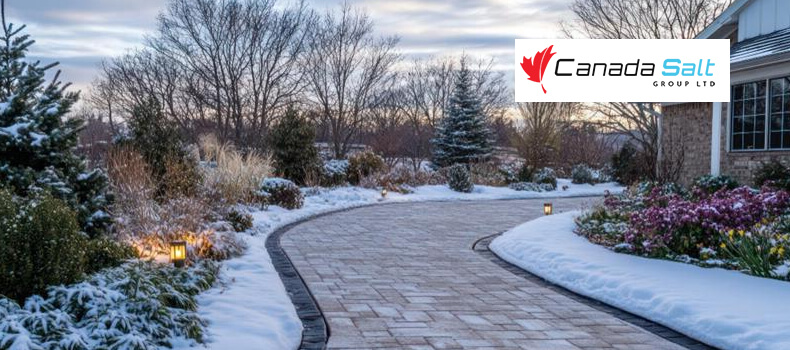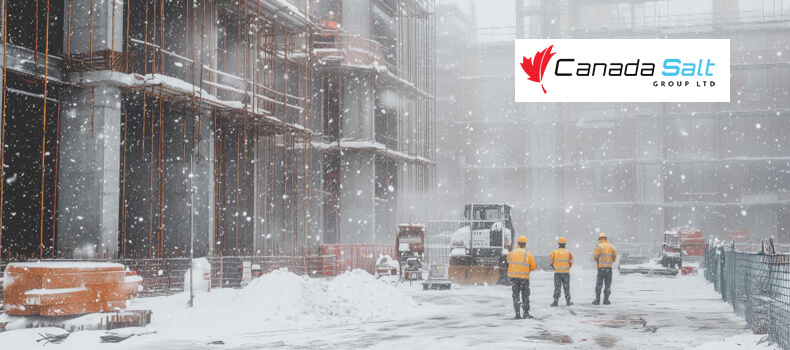Best Practices for De-icing Construction Sites and Access Roads
Winter is more than just snowflakes and cold winds. It presents numerous challenges for construction sites, such as slippery roads and frozen machines, which can exacerbate the situation. To withstand these risks, construction sites require effective de-icing strategies which is more than just spreading salt on the ground. It’s about proper planning, implementation, maintaining safety and maintaining eco-friendliness. Construction managers should be aware that properly de-icing the site can help prevent delays and avoid extra costs. In this article, we will explore the best practices for de-icing construction sites and access roads. Let’s get started!
Understanding the Impact of Ice on Construction Sites
Ice is not only an obstacle for construction projects, but it is also a serious safety hazard. Slippery areas due to the ice formation are a common cause of workplace injuries in winter. When ice accumulates on the scaffolds, cranes and ladders, it increases the risk of accidents on the site. Apart from safety issues, ice formation can cause delays in vehicle movement, projects and extra costs.
Also, freezing temperatures can cause battery damage, fluid thickening and fuel gelling, which can lead to mechanical failures of the equipment. Identifying these issues before lets construction managers take preventive steps accordingly and keep the site running all winter long.
Common De-icing Methods Used in Construction
There are various de-icing strategies which construction sites use. Sometimes they combine each of them for better coverage and safety. Common de-icing methods are:
- Chemical De-icing: Using salts and other de-icing agents to melt or prevent the formation of snow. Materials include sodium chloride, calcium chloride and magnesium chloride.
- Mechanical Removal: Snow can also be removed physically by using snow plows, shovels and graders before it is solidified
- Abrasive Materials: Materials like salt, cinders, and gravel are used to improve traction. These don’t directly contribute to the ice melting.
Each method has its own pros and cons. Therefore, you can combine these methods accordingly, depending on the site conditions, to achieve the most effective results.
Selecting the Right De-icing Products for Construction Sites
Not every de-icing product is the same. They work depending on the temperature, environmental regulations and the materials available on the construction site.
- Chloride-based deicers are affordable and commonly used de-icing agents in moderately cold climates. However, their effectiveness decreases when the temperature exceeds -10°C (14°F).
- When it comes to lower temperatures, calcium chloride and magnesium chloride are effective. Still, they can damage concrete and metal surfaces.
- Deicers, such as acetate-based calcium magnesium acetate, are more environmentally friendly alternatives, but they are quite expensive.
When using the above deicers, construction managers should consider all environmental and safety concerns and select the appropriate product for effective ice management.
Best Practices for Applying Deicers on Construction Access Roads
The correct application of de-icing materials is just as important as selecting the right type of material. Excessive or insufficient application of materials can lead to waste, reduced effectiveness, or even create safety issues. Here, timing and consistency matter. It is better to implement anti-icing, which involves applying salt before the storm starts. It will be easier to remove the snow later.
For access roads, mechanical spreaders can be used to achieve even distribution. For smaller areas, you can spread the salt by hand; however, larger construction sites may require truck-mounted or tow-behind spreaders. After applying, check the conditions and reapply if required.
De-icing Heavy Equipment and Machinery
Heavy equipment is an important component of any construction site. During winter, these machines can freeze, causing serious problems. Implementing proper de-icing practices for machinery is crucial for efficient operation. They are:
- Parking the equipment in covered or warm areas whenever possible.
- Utilizing engine blockers and battery warmers to prevent freezing of the components.
- Using fuel additives to prevent gelling of the fuel
- Avoiding hot water directly on the equipment
- Using specialized de-icing fluids
- Regular maintenance
Preventive Strategies to Reduce Ice Formation
When it comes to ice management, prevention is better than cure. A good site design and proper drainage planning are two of the most effective ways to prevent ice formation. Sloping the surfaces away from the construction site directs water away from the site rather than allowing it to freeze. Cover the important areas with thermal blankets, heating cables and insulated covers to cure the concrete and protect any underground utilities.
Another approach is to pre-treat the surfaces before snowfall to prevent ice from adhering to them, making snow removal easier. Using physical barriers, anti-icing methods, and proper drainage systems can help reduce the frequency of de-icing. This can save time, money and de-icing materials in the winter months.
Worker Safety During De-icing Operations
De-icing is a challenging job with many complications, which become even more complicated when working with heavy machinery and slippery conditions. So, proper worker safety is important. Essential safety measures which you need to follow are:
- Wearing appropriate personal protective equipment (PPE)
- Proper training is important
- Implementing a buddy system
- Conducting regular safety checks and site inspections
- Establishing clear communication channels
Weather Monitoring and Ice Prediction
Construction managers must anticipate and prepare for winter challenges in the most effective manner possible. Nowadays, due to advancements in technology, predicting weather and ice formation has become easier. Real-time weather monitoring devices and IoT sensors measure temperature, humidity, and ground conditions throughout the site, providing you with valuable insights. They also send you the notifications regarding the expected freezing conditions before the icy conditions become a risk.
Establishing a Winter Maintenance Plan
Every construction site should have a clear maintenance plan in place before the winter season begins. This acts as a guide on how to deal with snow, ice and other challenges that come with the winter season. The maintenance plan should outline all the roles and responsibilities that need to be performed, along with the responsible persons for each task, including preparing the equipment and handling emergencies.
A comprehensive plan should also include a checklist of de-icing materials, safety gear, and equipment to ensure that everything is ready before the first snowfall. Ensure clear communication within the team to prevent any risks. Also, conduct a review with yourself and your team at the end of winter to know what needs to be improved for the next time.
Legal and Regulatory Considerations
De-icing is a straightforward task, but it must comply with all relevant safety and environmental regulations. Construction companies should adhere to local, state, and federal laws regarding the use of de-icing chemicals and the management of runoff water. For instance, chloride-based deicers are restricted in some places as they can harm plants and groundwater sources. Ignoring these rules can result in environmental damage and heavy fines.
Employers must provide training to their staff on cold stress, provide the right protective gear, and maintain walking and driving areas safely. Staying updated on local regulations and maintaining records of compliance helps protect the company and its workers from potential risks.
Cost-Effective De-icing Strategies
We are aware that safety is paramount on any construction site. But managing costs is also important. Some of the cost-effective strategies are:
- Purchasing de-icing materials in bulk
- Using calibrated spreaders
- Pre-treating the surfaces
- Collaborating with local bulk salt suppliers
- Using multipurpose materials that provide traction and melting properties
Conclusion
De-icing the construction sites and access roads involves more than just removing the ice. It’s about maintaining the site in a safe and sustainable workplace, even during extreme weather conditions. Every step matters, from selecting the right materials to their effective use. Keep your construction site and access roads safer with reliable de-icing solutions from Canada Salt Group Ltd. We provide high-quality bulk road salt for your requirements. Contact us today for a free quote!





